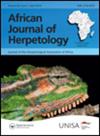A comparison of DNA barcoding markers in West African frogs
IF 0.9
4区 生物学
Q3 ZOOLOGY
引用次数: 12
Abstract
Abstract DNA barcoding has been proposed as a means of quick species identification using a short standardised segment of DNA. The established barcode gene for animals—the mitochondrial gene cytochrome oxidase one (CO1)—has been plagued by primer failure and low species identification success in amphibians. We investigate the accuracy of CO1 barcoding with a new dataset of West African frogs using the universal CO1 primers and new amphibian-specific CO1 primers in comparison to a proposed alternative DNA barcode for amphibians—the mitochondrial ribosomal 16s gene (16s). Research was performed using 134 specimens, comprising 21 species collected in Ghana, a global biodiversity hotspot with a deficiency of amphibian barcoding resources. These species represent 55% of amphibian species (58% of amphibian families) that are known in the area from surveys from 1988 to 2009. We found nearly a 50% increase in PCR amplification success using the amphibian-specific CO1 primers compared to the universal CO1 primers. However, the overall amplification and sequencing success of the amphibian-specific CO1 primers was low (78%) compared to the 16s gene (100%). Neither marker has a clear advantage in terms of barcoding gap; comparisons of intraspecific and interspecific variation for these markers were similar for the species we examined. Considering the qualities a barcoding gene should possess, 16s outperformed CO1 in terms of ease of obtaining sequences, and given that 16s sequences are better represented for African frogs on GenBank, this marker had higher success in BLAST searches. With amphibian species in fast decline, more consideration should be given to the appropriateness of collecting CO1 barcodes for amphibians, especially as an extensive genetic database for 16s already exists that can accurately identify amphibians.西非青蛙DNA条形码标记的比较
摘要DNA条形码是一种利用短的标准化DNA片段进行物种快速鉴定的方法。已建立的动物条形码基因-线粒体基因细胞色素氧化酶1 (CO1) -一直受到引物失败和两栖动物物种鉴定成功率低的困扰。我们利用西非青蛙的新数据集,使用通用的CO1引物和新的两栖动物特异性的CO1引物,研究了CO1条形码的准确性,并与两栖动物的线粒体核糖体16s基因(16s)的替代DNA条形码进行了比较。研究使用了134个标本,其中包括21个物种,采集于加纳,这是全球生物多样性热点地区,缺乏两栖动物条形码资源。从1988年到2009年的调查中,这些物种代表了该地区已知两栖动物物种的55%(两栖动物科的58%)。我们发现,与通用CO1引物相比,使用两栖类特异性CO1引物的PCR扩增成功率增加了近50%。然而,与16s基因(100%)相比,两栖类特异性CO1引物的总体扩增和测序成功率较低(78%)。在条形码差距方面,两种标记都没有明显的优势;这些标记的种内和种间变异比较在我们所研究的物种中是相似的。考虑到条形码基因应该具备的品质,16s在获得序列的便捷性方面优于CO1,并且考虑到16s序列在GenBank上对非洲青蛙有更好的代表,该标记在BLAST搜索中具有更高的成功率。随着两栖动物种类的快速减少,需要更多地考虑收集两栖动物CO1条形码的适宜性,特别是在已经有广泛的16s基因数据库可以准确识别两栖动物的情况下。
本文章由计算机程序翻译,如有差异,请以英文原文为准。
求助全文
约1分钟内获得全文
求助全文
来源期刊

African Journal of Herpetology
ZOOLOGY-
CiteScore
3.00
自引率
6.70%
发文量
15
审稿时长
>12 weeks
期刊介绍:
African Journal of Herpetology (AJH) serves as an outlet for original research on the biology of African amphibians and reptiles. AJH is an interdisciplinary journal that publishes original articles and reviews from diverse fields and disciplines, such as conservation, phylogenetics, evolution, systematics, performance, physiology, ecology, behavioural ecology, ethology, and morphology.
The Journal publishes two issues a year. There are no page charges .
 求助内容:
求助内容: 应助结果提醒方式:
应助结果提醒方式:


